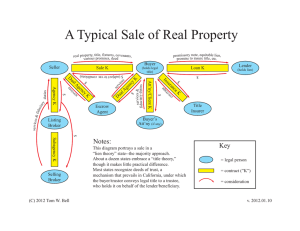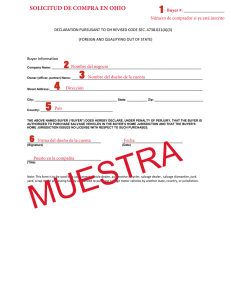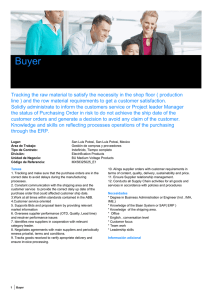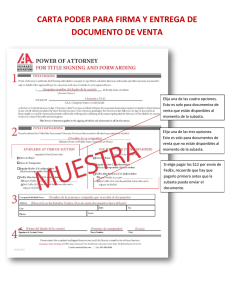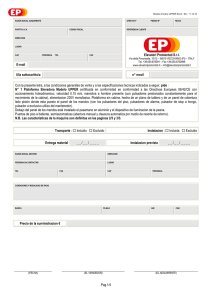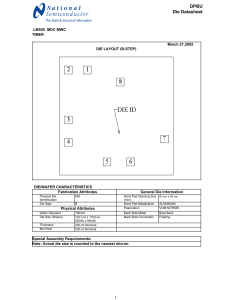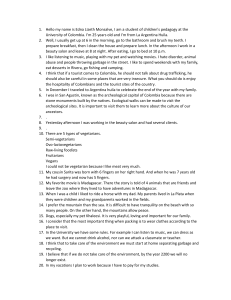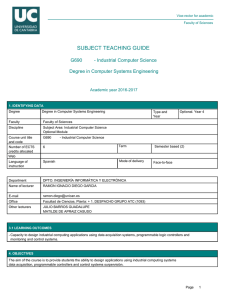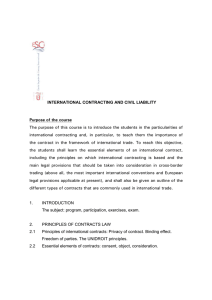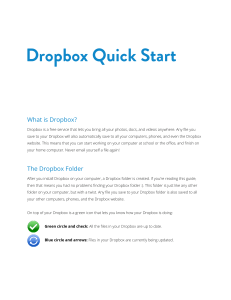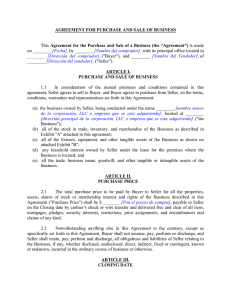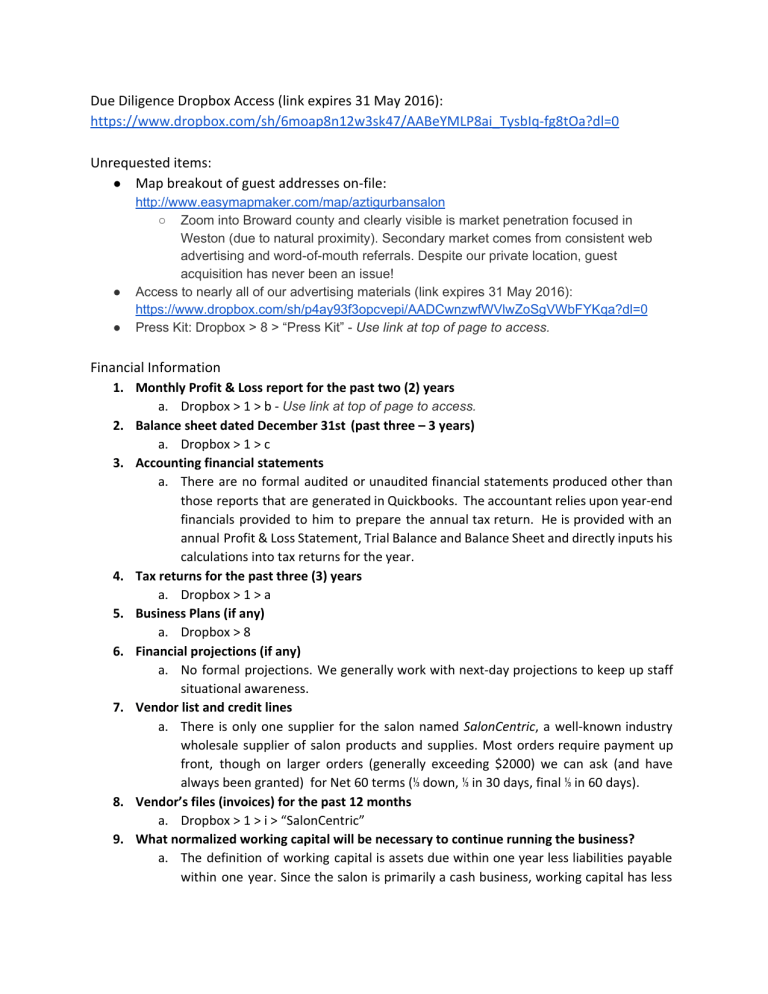
Due Diligence Dropbox Access (link expires 31 May 2016): https://www.dropbox.com/sh/6moap8n12w3sk47/AABeYMLP8ai_TysbIq­fg8tOa?dl=0 Unrequested items: ● Map breakout of guest addresses on­file: ● ● http://www.easymapmaker.com/map/aztigurbansalon ○ Zoom into Broward county and clearly visible is market penetration focused in Weston (due to natural proximity). Secondary market comes from consistent web advertising and word­of­mouth referrals. Despite our private location, guest acquisition has never been an issue! Access to nearly all of our advertising materials (link expires 31 May 2016): https://www.dropbox.com/sh/p4ay93f3opcvepi/AADCwnzwfWVlwZoSgVWbFYKqa?dl=0 Press Kit: Dropbox > 8 > “Press Kit” ­ Use link at top of page to access. Financial Information 1. Monthly Profit & Loss report for the past two (2) years a. Dropbox > 1 > b ­ Use link at top of page to access. 2. Balance sheet dated December 31st (past three – 3 years) a. Dropbox > 1 > c 3. Accounting financial statements a. There are no formal audited or unaudited financial statements produced other than those reports that are generated in Quickbooks. The accountant relies upon year­end financials provided to him to prepare the annual tax return. He is provided with an annual Profit & Loss Statement, Trial Balance and Balance Sheet and directly inputs his calculations into tax returns for the year. 4. Tax returns for the past three (3) years a. Dropbox > 1 > a 5. Business Plans (if any) a. Dropbox > 8 6. Financial projections (if any) a. No formal projections. We generally work with next­day projections to keep up staff situational awareness. 7. Vendor list and credit lines a. There is only one supplier for the salon named SalonCentric , a well­known industry wholesale supplier of salon products and supplies. Most orders require payment up front, though on larger orders (generally exceeding $2000) we can ask (and have always been granted) for Net 60 terms (⅓down, ⅓in 30 days, final ⅓in 60 days). 8. Vendor’s files (invoices) for the past 12 months a. Dropbox > 1 > i > “SalonCentric” 9. What normalized working capital will be necessary to continue running the business? a. The definition of working capital is assets due within one year less liabilities payable within one year. Since the salon is primarily a cash business, working capital has less 10. 11. 12. 13. 14. 15. meaning than in other types of businesses. Sales are made, supplies are purchased. The salon doesn’t typically have liabilities payable other than monthly credit card purchases used for the purchase of supplies or retail products for sale. What capital expenditures and other investments will need to be made to continue growing the business, and what are the company’s current capital commitments? a. While there are no required expenditures, the following are expenditures we would plan on making if we retained the business: i. Interior redecorating: Suggest removing the drywall ceiling in the main salon floor/hair wash area and pulling up the hardwood floor and polish the concrete for a more industrial chic look. Consider update to paint colors (will need to stick with something that keeps reflected light close to neutral to prevent it interfering with guest hair color results). ii. Consider retaining a brand manager or PR firm to enhance salon image and overall marketability to higher­income demographics. What is the condition of assets and liens thereon? a. Assets are all serviceable; no liens. What indebtedness is outstanding or guaranteed by the company, what are its terms, and when does it have to be repaid? a. N/A; acquisition does not include outstanding debts. What is the aging of accounts receivable (if any), and are there any other accounts receivable issues? a. AR is very small, as a salon, extending credit to guests is generally not advised except to proven and well­established guests on a very limited basis. Do they sell packages? Prepaid services? If so, please provide a detailed list of outstanding services. a. We do sell packages of prepaid services we call “series” ­ We offer the guest the opportunity to pay upfront for four of the same service and receive the fifth for free (amounts to a 20% discount). Current exposure can be found in: Dropbox > 1. Has EBITDA and any adjustments to EBITDA been appropriately calculated? (This is particularly important because the buyer is obtaining debt financing.) a. We’re not certain this truly applies since the buyer is not assuming any of our debt, though as a show of good­faith we’ve calculated EBITDA for 2015 using the following method: i. Note the last line of the 2015 Statement of Cash Flows (Dropbox > 1 > “2015 Statement of Cash Flows.pdf” = $18,953.28 ii. iii. Add back “Interest Expense” and “Depreciation Expense” from the 2015 P&L (Dropbox > 1 > b > “*2015 Overall P&L.pdf”) = $1,625.76 and $4,967.78 respectively. EBITDA 2015: $25,546.82 Tradename & Trademarks 1. What registered and common law trademarks and service marks does the company have? a. The salon owns servicemarks at both the Federal and State level and maintains a fictitious name registration at the State level. The Federal servicemark will need to be renewed this year; we can assist with this. Dropbox > 8. 2. What copyrighted products and materials are used, controlled, or owned by the company? a. There are no major revenue­generating items, though there is a YouTube channel with some useful videos. 3. What software is critical to the company’s operations (point of sale) and does the company have appropriate licenses for that software (and does the company’s usage of that software comply with use limitations or other restrictions)? a. SalonBiz is an enterprise­level software that scales well and is comprehensive (handles everything from appointment booking to inventory control and even time­tracking and commissions). The software is fully­licensed and use is legitimate. There are no practical limitations or restrictions to the use of the software, though it is primarily designed for salon/spa use. Customers/Sales. The buyer will want to fully understand the target company’s customer base including the level of concentration of the largest customers as well as the sales pipeline. Topics of inquiry or concern will include the following: 1. Who are the top 20 customers and what revenues are generated from each of them? a. Dropbox > 1 2. What customer concentration issues/risks are there? a. An industry­standard risk exists with each service provider on staff. Gross mismanagement of staff or working environment typically results in a partial or complete walk­out. Keeping staff reasonably content and working area healthy and fair is imperative to preventing a walk­out. 3. Will there be any issues in keeping customers after the acquisition (including issues relating to the identity of the buyer)? a. Retaining guests will not be an issue as a direct result of acquisition. We’ve strived to maintain a particular corporate image with all guests in order to build brand­loyalty versus stylist­loyalty. 4. How satisfied are the customers with their relationship with the company? (Customer calls will often be appropriate.) a. We gauge guest satisfaction via several methods, primarily by our online reputation ­­generally five­stars, or the highest rating available­­ on Yelp!, Facebook, and Google Place reviews. Consistent 5­star reviews across several platforms is virtually non­existent in any industry and is hopefully a testament to the way we interact with our guests. Next is our guest pre­book rate (exceeds 90%), and finally in­store verbal feedback. 5. What seasonality in revenue and working capital requirements does the company typically experience? a. If expenses are well­managed, working capital should not vary largely through the slow season, which roughly follows along with Broward county’s school year “summer” break. In opposition, the six weeks leading up to Thanksgiving and then through New Year’s is typically very busy if well­staffed and promotions fully advertised. 4. Strategic Fit with Buyer. The buyer is concerned not only with the likely future performance of the target company as a stand­alone business; it will also want to understand the extent to which the company will fit strategically within the larger buyer organization. Related questions and areas of inquiry will include the following: 1. Will there be a strategic fit between the company and the buyer, and is the perception of that fit based on a historical business relationship or merely on unproven future expectations? a. Having recently made the acquaintance of the buyer, it is reasonable to say that strategic fit would be based on future expectations. More subjectively, we feel the buyers would be an excellent fit given our last face­to­face interaction with them in the salon. 2. Does the company provide products, services, or technology the buyer doesn’t have? a. We’re not privy to the buyer’s other holdings. 3. Will the company provide key people and if so what is the likelihood of their retention following the closing? a. We will provide at least the current number of staff, including Shiela (one of the owners, for a limited time as described elsewhere) the head producer, and Arianna the salon manager. Arianna has given us a verbal commitment to stay on subsequent to acquisition, and we do not doubt her authenticity. As well, the CFO is willing to stay or transition or train a replacement. 4. What integration will be necessary, how long will the process take, and how much will it cost? a. Because we designed the business with an acquisition in mind, nearly every system is scaleable, severable, and well­documented. Combined with retaining current staff (the manager in particular), and our follow­on commitments (formal and informal), the process should take about 4­6 weeks. 1­2 weeks of getting acquainted, then 2­4 weeks of hands­on changeover. Costs should also be minimal if non­existent. 5. What cost savings and other synergies will be obtainable after the acquisition? a. We’ve worked with our advertisers to ensure they offer the buyer the same or similar advertising packages or working relationships that we’ve had good results with. Namely YP (YellowPages online), SalonCentric, Yelp!, and even the building owner. Ordinarily, approaching these companies and asking for their current retail or service offerings yield higher prices than what we’ve established through years of working with them previously. 6. What marginal costs (e.g., costs of obtaining third party consents) might be generated by the acquisition? a. None. To our knowledge, we’ve never over­committed our business to this extent. 7. What revenue enhancements will occur after the acquisition? a. It would be difficult for us to attempt to answer this without knowing more about the buyer's goals and access to capital. There are additional profit centers available in the salon (plumbing in the spa area) which could be opened up if the buyer so desired. 5. Material Contracts. One of the most time­consuming (but critical) components of a due diligence inquiry is the review of all material contracts and commitments of the target company. The categories of contracts that are important to review and understand include the following: 1. Guaranties, loans, and credit agreements a. No guaranties (released from all after years of relationship management and negotiation), loans and credit agreements not part of acquisition. 2. Customer and supplier contracts a. None. 3. Agreements of partnership or joint venture; limited liability company or operating agreements a. Articles of Incorporation for Propaganda, Inc. (for reference; not part of the acquisition) and fictitious name registrations. Dropbox > 8. 4. Contracts involving payments over a material dollar threshold a. None. 5. Settlement agreements a. Dropbox > 2 > b > Walkout 2014 > “Jerome Settlement.pdf” 6. Past acquisition agreements a. None. 7. Equipment leases a. None. 8. Indemnification agreements a. No standalone agreements; they’re a standard clause in almost every software license nowadays. 9. Employment agreements a. None. 10. Exclusivity agreements a. None ­ be sure your lease agreement contains one for “cosmetology services” ­ we can try to help you obtain this. 11. Agreements imposing any restriction on the right or ability of the company (or a buyer) to compete in any line of business or in any geographic region with any other person a. None. 12. Real estate leases/purchase agreements a. None. 13. License agreements a. None. 14. Powers of attorney a. None. 15. Franchise agreements a. None. 16. Equity finance agreements a. None. 17. Distribution, dealer, sales agency, or advertising agreements a. None currently ­ willing to assist negotiations! 18. Non­competition agreements a. None. 19. Union contracts and collective bargaining agreements a. None. 20. Contracts the termination of which would result in a material adverse effect on the company a. None. 21. Any approvals required of other parties to material contracts due to a change in control or assignment a. None. 6. Employee/Management Issues. The buyer will want to review a number of matters in order to understand the quality of the target company’s management and employee base, including: 1. Management organization chart and biographical information a. Available in business plan, pages 15­19: Dropbox > 8 > “AZtiG Urban Salon Business Plan [CONFIDENTIAL].pdf” 2. Summary of any labor disputes a. None. 3. Information concerning any previous, pending, or threatened labor stoppage a. None currently. Experienced a partial Walkout in 2014. All information available in Dropbox > 2 > b > “Walkout 2014” b. Summary: Two former staff members conspired to obtain guest information and establish themselves at a location within a previously agreed­upon exclusion zone (non­disclosure/non­compete). Settlement info provided previously in this document. 4. Employment and consulting agreements, loan agreements, and documents relating to other transactions with officers, directors, key employees, and related parties a. None. 5. Schedule of compensation paid to officers, directors, and key employees for the three most recent fiscal years showing separately salary, bonuses, and non­cash compensation (e.g., use of cars, property, etc.) a. The only regularly scheduled compensation of officers is salary, which has been consistent until recently. In 2013 and 2014, both officers’ salaries were $18,000 per year. In 2015, with one principal’s reduced role, the salary was reduced to $5,200 per year. The CFO compensation has always been $7,800 per year. There is no non­cash compensation other than that disclosed in Item 8 below. 6. Summary of employee benefits and copies of any pension, profit sharing, deferred compensation, and retirement plans a. Paid­Time Off and Sick days accruing and not to exceed 10 and 3 days per year. No other benefits or deferred compensation offered. 7. Evidence of compliance with IRS Section 409A in connection with stock option issuances a. N/A ­ stock options not issued. 8. Summary of management incentive or bonus plans not included in above as well as other forms of non­cash compensation a. Owner fringe benefits only; leased car & insurance, health insurance. 9. Likelihood of need for compliance with IRS Section 280G (golden parachute) rules in connection with any potential acquisition a. None. 10. Employment manuals and policies a. All digital on company intranet. Outside access can be provided by prior arrangement, just let us know. We will need the IP address of the computer from which you desire access; obtain that by visiting http://www.ipchicken.com and relaying the number shown. 11. Involvement of key employees and officers in criminal proceedings or significant civil litigation a. None. 12. Plans relating to severance or termination pay, vacation, sick leave, loans, or other extensions of credit, loan guarantees, relocation assistance, educational assistance, tuition payments, employee benefits, workers’ compensation, executive compensation, or fringe benefits a. None. 13. Appropriateness of the company’s treatment of personnel as independent contractors vs. employees a. This is unfortunately a key point of abuse by a great deal of salon owners. Cognizant of this, we have always fully­informed every team member of the differences and what they can expect. That being said, both W2 and 1099 arrangements are appropriate for service providers. Generally all other staff ought to be W2. 14. Actuarial reports for past three years a. None. 15. What agreements/incentive arrangements are in place with key employees to be retained by the buyer? Will these be sufficient to retain key employees? a. We’ve come to verbal agreements, at our personal expense, with Arianna (manager/reception) and Mitchell (Lead Stylist) to incentivize their retention. 16. What layoffs and resultant severance costs will be likely in connection with the acquisition? a. None. 7. Litigation. An overview of any litigation (pending, threatened, or settled), arbitration, or regulatory proceedings involving the target company is typically undertaken. This review will include the following: 1. Filed or pending litigation, together with all complaints and other pleadings a. None. 2. Litigation settled and the terms of settlement a. Previously described. 3. Claims threatened against the company a. None. 4. Consent decrees, injunctions, judgments, or orders against the company a. None. 5. Attorneys’ letters to auditors a. None. 6. Insurance covering any claims, together with notices to insurance carriers a. None. 7. Matters in arbitration a. None. 8. Pending or threatened governmental proceedings against the company (SEC, FTC, FDA, etc.) a. None. 9. Potentially speaking directly to the company’s outside counsel a. None retained. 8. Tax Matters. Tax due diligence may or may not be critical, depending on the historical operations of the target company, but even for companies that have not incurred historical income tax liabilities, an understanding of any tax carryforwards and their potential benefit to the buyer may be important. Tax due diligence will often incorporate a review of the following: 1. Federal, state, local, and foreign incomes sales and other tax returns filed in the last five years a. S­Corp election permits an evaluation of our 1120S for anticipated tax liabilities without referring to personal returns. 2. Government audits a. None. 3. Copies of any correspondence or notice from any foreign, federal, state, or local taxing authority regarding any filed tax return (or any failure to file) a. None that are not routine (filings received, issuance of sales tax certificate, etc.) 4. Tax sharing and transfer pricing agreements a. None. 5. Net operating losses or credit carryforwards (including how a change in control might affect the availability thereof) a. There will be no loss or credit carryforwards. 6. IRS Form 5500 for 401(k) plans a. N/A 7. Agreements waiving or extending the tax statute of limitations a. N/A 8. Allocation of acquisition purchase price issues a. None anticipated. 9. Correspondence with taxing authorities regarding key tax items a. N/A 10. Settlement documents with the IRS or other governmental taxing authorities a. N/A 9. Antitrust and Regulatory Issues. Antitrust and regulatory scrutiny of acquisitions has been increasing in recent years. The buyer will want to undertake the following activities in order to assess the antitrust or regulatory implications of a potential deal: 1. If the buyer is a competitor of the target company, understanding and working around any limitations imposed by the company on the scope or timing of diligence disclosures a. N/A 2. Analyzing scope of any antitrust issues a. N/A 3. If the company is in a regulated industry that requires approval of an acquisition from a regulator, understanding the issues involved in pursuing and obtaining approval a. N/A 4. Confirming if the company has been involved in prior antitrust or regulatory inquiries or investigations a. Never. 5. Addressing issues that may be involved in preparing a Hart­Scott­Rodino filing (if thresholds are met) and effectively responding to any “second request” from the Department of Justice or Federal Trade Commission a. N/A 6. Considering Exon­Florio issues if the transaction involves national security or foreign investment issues a. No concerns on our end. 7. Other Department of Commerce filings if the buyer is a foreign entity a. No concerns on our end. 8. Understanding how consolidation trends in the company’s industry might impact the likelihood and speed of antitrust or regulatory approval a. N/A 10. Insurance. In any acquisition, the buyer will want to undertake a review of key insurance policies of the target company’s business, including: 1. If applicable, the extent of self­insurance arrangements a. N/A 2. General liability insurance a. Dropbox > 7 3. D&O insurance a. None. 4. Intellectual property insurance a. None. 5. Car insurance a. N/A; Auto not included in acquisition. 6. Health insurance a. None. 7. E&O insurance a. N/A 8. Key man insurance a. None. 9. Employee liability insurance a. None. 10. Worker’s compensation insurance a. Dropbox > 7 11. Umbrella policies a. Glass; Dropbox > 7
